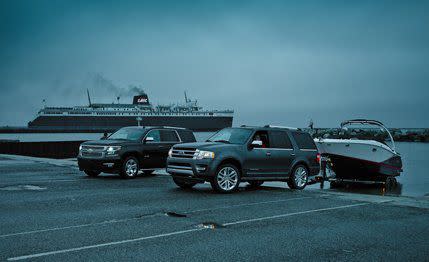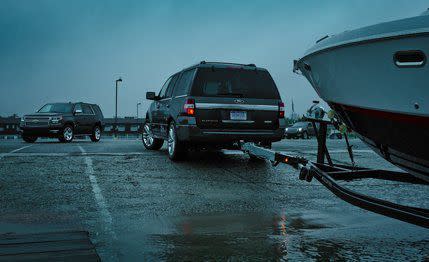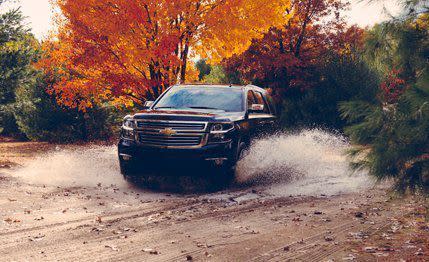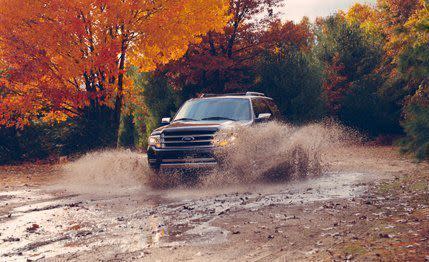2015 Chevy Tahoe LTZ vs. 2015 Ford Expedition Platinum

From the January 2015 issue of Car and Driver
Amid the industry’s booming sales of compact wagonoids on stilts, domestic full-size SUVs stand out like the mountains of metal they are: truck-based behemoths capable of towing more than four tons while seating up to eight people. Despite their excesses, these giants remain indispensable for their vast range of capabilities. While both of the segment’s icons, the Chevrolet Tahoe and the Ford Expedition, see a significant evolution for 2015, each applies its own formula for taking an entire homestead on holiday.
The Tahoe follows the path of the latest Chevy Silverado 1500, borrowing its updated boxed frame and 5.3-liter small-block V-8 with aluminum block-and-head construction, direct fuel injection, variable valve timing, and cylinder deactivation. Its 355 horsepower and 383 pound-feet of torque motivate a stylish, if conventional, rig that stands apart from the donor pickup with more of its own sheetmetal and rear coils instead of leaf springs. In a first for the ute, even its front doors are different from the Silverado’s.

There’s still a rudimentary solid axle slung under the rear, but new Magnetic Ride Control dampers (exclusive to range-topping LTZ models like our 4x4 test truck) help manage nearly three tons of SUV with commendable poise. A fresh interior design similar to the Silverado’s welcomes occupants with soft materials, vibrant digital readouts, and all-day comfort.
All that comes at a price, though, with our example starting at $64,530 before adding the $500 Max Trailering package (3.42:1 axle ratio, trailer-brake controller, upgraded Z71 suspension, and two-speed transfer case) and $400 20-inch chrome wheels. Entry-level Expeditions start a couple grand less than a base Tahoe ($44,585 versus $46,745, respectively), but the top-spec Platinum 4x4 seen here stickered at $64,365, including $2180 for massive 22-inch polished aluminum wheels.

Unlike the Tahoe, the F-150–based Expedition has changed little since its last refresh in 2007. Yet even it employs a modern independent rear suspension. And we would be remiss if we failed to mention that it gains a few new tricks for 2015: three-way adjustable dampers that come with the big rollers, as well as a standard 3.5-liter EcoBoost V-6 making 365 horsepower at 5000 rpm and 420 pound-feet of torque at 2500 rpm. In addition to new lighting elements and subtle exterior sculpting, there’s a revised instrument panel and steering wheel, dual 4.2-inch readouts in the cluster, and a reworked center stack housing an available eight-inch screen for MyFord Touch control.
Knowing that owners often take these trucks on fall-color treks to vacation cottages, we hit the test track and then set course for scenic Ludington, Michigan, on the sandy coast of our state’s eponymous lake. For good measure, we also contacted Four Winns Boats in Cadillac, Michigan, which lent us a gleaming-new Signature H260 ski boat and trailer ($115,976). Hauling this 26-foot-long, 7000-pound payload out of the water for the season was an ideal—and realistic—challenge for these titans. Both trucks were thoroughly engineered for the voyage and didn’t disappoint, though only one returned the winner.
While the latest Tahoe is far more advanced than the original that helped spark the SUV explosion of the 1990s, it hasn’t evolved as adeptly as the Expedition in key areas.
Looking like a windswept brick, the Tahoe’s new sheetmetal is creased and handsome, with a high beltline that gives it an angry, chopped-top mien. But this can make occupants feel as if they’re sitting in a giant, waterless bathtub, and outward visibility suffers from the smaller greenhouse. We could do with less chrome, too.
Both trucks have plenty of luxury touches, from heated and cooled seats to excellent rearview cameras that make it a snap to hitch up a trailer in one go. It takes more of a step to get into the Chevy than the Ford, but the former’s cabin is the nicer of the two, as long as you’re in the front. It has 73 cubic feet of front seating space versus 62 in the Ford. It also has smarter controls with larger buttons and knobs, and nicer materials. The seats are more supportive for wider frames, too, though they’re firmer than the plushy Ford’s.

While a conventional middle-row bench seat is a no-cost option, our truck had power-folding captain’s chairs. The setup limits seating to just four occupants if you want to carry any significant bulk, though the individual thrones are high on comfort and make easy work of getting to the way back. But there are only 32 cubes of cargo space with the rear-most row folded flat, versus 43 in the Ford. That’s largely a result of the higher load floor necessary to clear the Chevy’s solid rear axle. Third-row seating here should be reserved for children and adults you don’t like.
The Tahoe manages its 5670 pounds surprisingly well. The ride is tame over smoother surfaces; the factory setting on the nonadjustable magnetorheological shocks is a good one. And there’s a planted, confidence-inspiring feel in corners that also makes towing a big trailer drama-free. But the Chevy’s old-school suspension doesn’t let it float down the road like the Ford or stay as settled over broken pavement.

The Tahoe’s quick, hefty tiller (3.4 turns lock-to-lock versus 3.7) gives it over-the-road authority, but the Expedition, which is 485 pounds heavier, was actually the speedier of the two through our slalom test by nearly 3 mph. The Chevy also needed 180 feet to stop from 70 mph, an additional 10 over the Ford.
Nor could the lighter Tahoe match the Expedition in straight-line acceleration, despite both trucks having similar six-speed automatic transmissions and two-speed four-wheel-drive systems. Not that 6.7 seconds to 60 mph (plus 15.2 in the quarter-mile at 92 mph) is slow for a small house, but the Expedition was consistently a tenth or two or three ahead below 100 mph. True, the Chevy’s 17-mpg average for our 500-mile round trip was one better than the Ford’s, including 20 or so miles of towing, during which the Chevy V-8 occasionally ran in four-cylinder mode. This was despite the Expedition’s smaller, high-tech engine and Ford’s promise of improved efficiency without compromising power. But the small-block’s 4100-rpm torque peak never provided the instant thrust of the Expedition’s boosted V-6, nor the pull we expected from its burly exhaust note. With a carlike feel that some drivers preferred to the truckish Ford, the latest Tahoe is a highly polished and immensely capable SUV. But the Expedition is better in many meaningful ways.
Ignore the big wheels and fresh details, and the latest Expedition just sort of blends in. It’s definitely big—nearly three inches taller and riding on a wheelbase three inches longer than the Tahoe’s—but this is mostly the same truck that Ford has churned out for years.
Yet, despite its girth and seemingly near-static sameness, the big Ford is admirably light on its feet, winning almost every performance test. There’s only 0.78 g of lateral grip on the skidpad, and its softer suspension tune permits more head toss than in the Chevy. But the Expedition’s center of gravity is actually 0.5 inch lower than the Tahoe’s. Combined with a smidge less than 50 percent of its weight over the front wheels, directional changes are more secure. There’s a noticeable difference between settings for the new continuous control suspension’s shocks (comfort, normal, sport), but the controls are buried in the gauge-cluster menus, so we usually left it in the default setting, which is all-around pleasant.

Not only does the Expedition’s independent rear suspension make for a steadier ride over rough terrain, its superior packaging permits a lower cargo floor that’s much easier to load with gear. When it comes to seating, the eight-passenger Expedition shines with a three-abreast middle bench and a third row that can seat real full-size adults. Plus, both rows fold flat. More glass area than in the Tahoe, including the Platinum’s standard power sunroof, ensures that all occupants get a scenic view.
Whether hitched to the boat or on its own, the Expedition, which can tow up to 9200 pounds versus the Tahoe’s 8400, always felt stable and powerful. The EcoBoost V-6 is a torque mill, and it works smartly with the six-speed automatic to keep the truck pulling when the Chevy’s V-8 is straining for revs. A 6.4-second run to 60 mph and 15 flat in the quarter are more than adequate. The Expedition’s 16-mpg average (one less than its EPA combined rating) is a reminder of how much weight you’re carrying, and the quiet thrum of the V-6 can sound odd coming from such a large rig. Nevertheless, this is an excellent powerplant for a large truck.

The Ford’s ambience behind the wheel is a little stale, from the blocky design to the tacky faux-wood trim and acres of hard plastic. The plethora of menus and data from the various displays can be daunting, and the tiny buttons are sized for elfin hands. The Platinum’s two-tone leather spices things up a bit, and the ride is as similarly hushed as the Chevy’s. But while both trucks were more than capable of handling our lakeside adventure, the Ford imposed fewer compromises.
It may not be as new or efficient as the Tahoe, but the Expedition is a bit cheaper, and more powerful, flexible, and capacious. For a vehicle that will likely haul a bit of everything over its lifetime, such versatility makes it hard to beat.


You Might Also Like

 Yahoo Autos
Yahoo Autos 